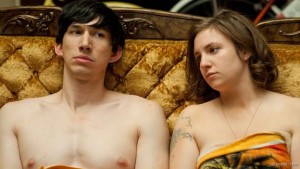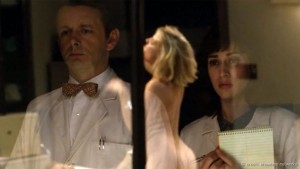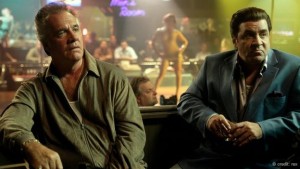From its first episode in 2011, HBO’s Game of Thrones gave us sex like nothing else that had been seen on US television: incest, oral sex, orgies, brothels, breasts, breasts and more bare breasts. The next year, the network’s very different new show, Girls, made headlines for a similar reason: its young stars’ penchant for stripping down to perform in graphic sex scenes. By 2013, after so much skin and so many titillating trysts, an entire show about sex – Showtime’s 1950s period drama Masters of Sex, about researchers William Masters and Virginia Johnson’s unusual lab work and relationship – seemed almost quaint.
Back in the time in which Masters of Sex is set, sex was so taboo that even married couples on television like Lucy and Ricky Ricardo of I Love Lucy, had to be shown sleeping in separate beds. When Lucy (miraculously) got knocked up, even the word “pregnant” was verboten on the small screen. By the 1970s, couples were finally sharing mattresses and talk about sex had loosened up, allowing Maude’s title character to get an abortion, The Mary Tyler Moore Show’s Mary Richards to imply that she was on the pill, and Soap’s Jodie Dallas to identify as gay.
The ‘golden age of TV drama’ has also ushered in a golden age of sex on the small screen
Now, as Masters of Sex returns for a third season on US TV, explicit scenes on the small screen are standard: we assume they come with the territory on any adult drama like The Americans, The Affair, Scandal,How to Get Awaywith Murder, House of Cards,Orphan Black,Transparent or Outlander. The ‘golden age of TV drama’ has also ushered in a golden age of sex on the small screen. Surely social media has encouraged shows to push boundaries, rewarding any shocking scenes with trending Twitter hashtags. But intriguingly, movies have moved in the opposite direction, becoming less and less graphic as they struggle to reach larger – that is, more mainstream – audiences. With family moviegoers as their target audience and without broadcast’s unifying potential, the film industry has chosen a different tack.
Pay-cable networks like Showtime, which airs Masters of Sex, are not subject to as restrictive of content regulations as broadcast channels in the US (Credit: Showtime Networks)
For adults only?
As Hollywood grows more prudish, TV has become the go-to place for hot-and-heavy fare. The biggest factor in this reversal is that the two media have essentially switched roles in US culture. Until recently, film was the ‘cooler’: more artistic, more visionary, the place where boundaries were pushed. TV was the minor leagues, a place for crass, mass diversions, not art or even ’mature’ entertainment. TV was supposed to be for everyone. In fact, in 1975, just as TV was becoming more sophisticated and complicated, protests from the Christian right forced the Federal Communications Commission to call for a “family viewing hour” during the first 60 minutes of prime time. The action was ultimately overturned in court in 1977, but not before it wreaked havoc on networks’ schedules, prompting a deadly move to Monday nights for the long-running Saturday-night CBS hit All in the Family and possibly hastening the end of The Mary Tyler Moore Show.
But in the early 2000s, HBO rose to grand prominence with television series that aspired to art. David Chase created The Sopranos, with gritty 1970s cinema from the likes of Francis Ford Coppola and Martin Scorsese as his model. (The Bada Bing! strip club certainly upped the nudity quotient, and Tony Soprano’s wandering ways added plenty of sex.) From there, TV got serious, with anti-heroes, beautiful cinematography, well-crafted scripts, great acting – and lots of serious adult content – in series such as Mad Men, Breaking Bad, Lost,Dexter, The Good Wife, Homeland and House of Cards. Cable and streaming services also played a major part: with fewer restrictions from the Federal Communications Commission to hold them back, their programmes could catch viewers’ attention in more provocative ways. TV became in the 2000s what film had been in the 1960s and ‘70s.
The Sopranos brought a new level of maturity to TV storytelling – and a willingness to depict graphic sexuality (Credit: Rex)
Hollywood now gives us lots of CGI and explosions but very little se
Meanwhile, the movie business has changed radically. As studios have chased larger profits, they’ve reverted almost exclusively to making franchise films with built-in audience recognition. And bigger and bigger investments for major stars and massive special effects have meant that these movies play to the widest audiences, both in the United States and abroad. The result: lots of CGI and explosions but very little sex. In targeting a global audience, Hollywood has become very aware of regional sensitivities and taboos regarding explicit content. The few hits that do feature lots of skin, like Fifty Shades of Grey and the Magic Mike franchise, are all but labeled “THIS IS ABOUT SEX.” There is little room for subtlety here. And the box office numbers bear out the family-friendly approach: Jurassic World and Pixar’s Inside Out beat Magic Mike XXL in its opening weekend, pushing the strippers-on-the-road movie to number four in box office returns on its opening weekend.
Taking chances
Grey’s Anatomy made TV sex feminist, with cunnilingus scenes, serious lesbian relationships and a prominent call-out to the “va-jay-jay”
Writer-producer Shonda Rhimes’ explosive breakthrough with Grey’s Anatomy in 2005 started US network TV simmering with its large cast of beautiful doctors getting it on in supply closets and break rooms in between lifesaving surgery. And Grey’s didn’t just exploit sex; it made TV sex feminist, with cunnilingus scenes, serious lesbian relationships and a prominent call-out to the “va-jay-jay” almost by name. Rhimes kept her brand consistent throughout her subsequent soapy creations, Private Practice, Scandal, and How to Get Away With Murder. Her shows also pioneered explicit gay sex scenes outside the boundaries of pay-cable shows specifically about gay characters, such Queer as Folk and The L Word.
Orange Is the New Black, meanwhile, has rescued lesbian sex scenes from pornography. There’s nothing more clichéd in porn than two chicks getting it on in prison (and the show, it must be noted, sometimes veers). But Orange has humanised such interactions, making them as idiosyncratic as the women who engage in them. Some are sweet. Some are exploitative. Some are romantic. Some are cringe-worthy. Several of the women do not have traditionally idealised body types. In the end, what’s most clear is that woman-on-woman sex in prison is normalised. We root for some of the relationships and hate others, the same as we have done for decades of heterosexual relationships on screen.
The Netflix series Grace and Frankie explores the sexuality of older people and shatters taboos about aging and sex (Credit: Netflix)
Netflix’s Grace and Frankie does the same for older people’s sex lives. The premise hinges on the two title characters’ husbands leaving them for each other – an obvious admission that sex still matters to these 70-somethings. The wives left behind waste no time in finding new potential partners, particularly Jane Fonda’s Grace, who gives her paramour, played by Craig T Nelson, a sweetly played, but still quite clear, lesson in foreplay.
These shows may prove the worn adage that sex sells, but they often sell it to us in innovative, artistic thought-provoking ways that challenge society’s norms. That’s the kind of ‘adult entertainment’ it’s worth staying home from the movies for.






